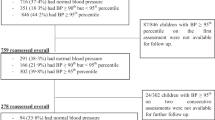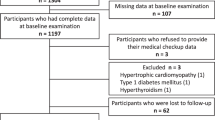Abstract
Gestational age and birth weight are supposed to associate with childhood blood pressure but remains unclear. This study aimed to investigate the association between gestational age, birth weight, and blood pressure among Chinese children. In all, 49 357 children aged 6–18 years were included from a nationwide survey in China. Gestational age, birth weight, and socioeconomic data were collected by questionnaires. Systolic (SBP) and diastolic (DBP) blood pressure were objectively measured. The associations between birth measures and blood pressure were examined by multivariable linear regression and logistic regression. The prevalence of hypertension was 19.1%, 19.2%, and 21.0% in preterm, term, and post-term subgroups, and 20.1%, 19.1%, and 19.8% in low-, normal-, and high-birth-weight subgroups, respectively. Results showed significantly positive associations of gestational age with SBP, DBP, SBP z-score, and DBP z-score in the overall and term subgroup, but not in the preterm or post-term subgroup. Birth weight was inversely related to SBP, DBP, SBP z-score, and DBP z-score across the entire birth-weight spectrum, and the overall association was stronger in girls than in boys. Similar associations were found in diffident age subgroups. Children with high birth weight had decreased odds of hypertension (OR 0.84, 95% CI 0.77–0.92) after adjustment for covariates. Preterm birth increased the risk of high SBP only in boys. This study suggested that gestational age was positively associated with blood pressure only in term-born children. Birth weight had a negative association with childhood blood pressure across the whole range of birth weight.
This is a preview of subscription content, access via your institution
Access options
Subscribe to this journal
Receive 12 digital issues and online access to articles
$119.00 per year
only $9.92 per issue
Buy this article
- Purchase on Springer Link
- Instant access to full article PDF
Prices may be subject to local taxes which are calculated during checkout

Similar content being viewed by others
References
Chen W., Gao R., Liu L., Zhu M., Wang W., Wang Y., et al. Report on cardiovascular disease in China (2014). Chin Circ J. 2015;30:617–22.
Chen X, Wang Y. Tracking of blood pressure from childhood to adulthood: a systematic review and meta-regression analysis. Circulation. 2008;117:3171–80.
de Boo HA, Harding JE. The developmental origins of adult disease (Barker) hypothesis. Aust N Z J Obstet Gynaecol. 2006;46:4–14.
Falkner B, Hulman S, Kushner H. Effect of birth weight on blood pressure and body size in early adolescence. Hypertension. 2004;43:203–7.
Crump C, Winkleby MA, Sundquist K, Sundquist J. Risk of hypertension among young adults who were born preterm: a Swedish national study of 636,000 births. Am J Epidemiol. 2011;173:797–803.
Vohr BR, Allan W, Katz KH, Schneider KC, Ment LR. Early predictors of hypertension in prematurely born adolescents. Acta Paediatr. 2010;99:1812–8.
Derraik JGB, Rowe DL, Cutfield WS, Hofman PL. Decreasing birth weight is associated with adverse metabolic profile and lower stature in childhood and adolescence. PLoS ONE. 2015;10:e119433.
Chiolero A, Paradis G, Kaufman JS. Assessing the possible direct effect of birth weight on childhood blood pressure: a sensitivity analysis. Am J Epidemiol. 2013;179:4–11.
de Jong F, Monuteaux MC, van Elburg RM, Gillman MW, Belfort MB. Systematic review and meta-analysis of preterm birth and later systolic blood pressure. Hypertension. 2012;59:226–34.
Menezes AMB, Hallal PC, Horta BL, Araujo CLP, de Fatima Vieira M, Neutzling M, et al. Size at birth and blood pressure in early adolescence: a prospective birth cohort study. Am J Epidemiol. 2007;165:611–6.
Leunissen RWJ, Kerkhof GF, Stijnen T, Hokken-Koelega ACS. Effect of birth size and catch-up growth on adult blood pressure and carotid intima-media thickness. Horm Res Paediatr. 2012;77:394–401.
Lurbe E, Garcia-Vicent C, Torro MI, Aguilar F, Redon J. Associations of birth weight and postnatal weight gain with cardiometabolic risk parameters at 5 years of age. Hypertension. 2014;63:1326–32.
Bowers K, Liu G, Wang P, Ye T, Tian Z, Liu E, et al. Birth weight, postnatal weight change, and risk for high blood pressure among chinese children. Pediatrics. 2011;127:e1272–9.
Wei JN, Li HY, Sung FC, Lin CC, Chiang CC, Li CY, et al. Birth weight correlates differently with cardiovascular risk factors in youth. Obes (Silver Spring). 2007;15:1609–16.
Rice M, Turner-Henson A, Park N, Azuero A, Amiri A, Feeley CA, et al. Child and maternal factors that influence child blood pressure in preschool children: an exploratory study. Appl Nurs Res. 2016;31:117–20.
Chen Y, Ma L, Ma Y, Wang H, Luo J, Zhang X, et al. A national school-based health lifestyles interventions among Chinese children and adolescents against obesity: rationale, design and methodology of a randomized controlled trial in China. BMC Public Health. 2015;15:210.
Hui F., Yinkun Y., Jie M. Updating blood pressure references for Chinese children aged 3-17 yeas. Chin J Hypertens. 2017;25:428–35.
Daniels SR. How to define hypertension in children and adolescents. Circulation. 2016;133:350–1.
Falkner B, Daniels SR. Summary of the Fourth Report on the Diagnosis, Evaluation, and Treatment of High Blood Pressure in Children and Adolescents. Hypertension. 2004;44:387–8.
Johansson S. Risk of high blood pressure among young men increases with the degree of immaturity at birth. Circulation. 2005;112:3430–6.
Beltrand J, Soboleva TK, Shorten PR, Derraik JGB, Hofman P, Albertsson-Wikland K, et al. Post-term birth is associated with greater risk of obesity in adolescent males. J Pediatr. 2012;160:769–73.
Ayyavoo A, Derraik JG, Hofman PL, Mathai S, Biggs J, Stone P, et al. Pre-pubertal children born post-term have reduced insulin sensitivity and other markers of the metabolic syndrome. PLoS ONE. 2013;8:e67966.
Steinthorsdottir SD, Eliasdottir SB, Indridason OS, Palsson R, Edvardsson VO. The relationship between birth weight and blood pressure in childhood: a population-based study. Am J Hypertens. 2013;26:76–82.
Huxley RR, Shiell AW, Law CM. The role of size at birth and postnatal catch-up growth in determining systolic blood pressure: a systematic review of the literature. J Hypertens. 2000;18:815–31.
Huxley R, Neil A, Collins R. Unravelling the fetal origins hypothesis: is there really an inverse association between birthweight and subsequent blood pressure? Lancet. 2002;360:659–65.
Chiolero A, Paradis G, Madeleine G, Hanley JA, Paccaud F, Bovet P. Birth weight, weight change, and blood pressure during childhood and adolescence. J Hypertens. 2011;29:1871–9.
Zhang Y, Li H, Liu SJ, Fu GJ, Zhao Y, Xie YJ, et al. The associations of high birth weight with blood pressure and hypertension in later life: a systematic review and meta-analysis. Hypertens Res. 2013;36:725–35.
Bouhours-Nouet N, Dufresne S, de Casson FB, Mathieu E, Douay O, Gatelais F, et al. High birth weight and early postnatal weight gain protect obese children and adolescents from truncal adiposity and insulin resistance: metabolically healthy but obese subjects? Diabetes Care. 2008;31:1031–6.
O’Sullivan J, Wright C, Pearce MS, Parker L. The influence of age and gender on the relationship between birth weight and blood pressure in childhood: a study using 24-hour and casual blood pressure. Eur J Pediatr. 2002;161:423–7.
Seckl JR. Prenatal glucocorticoids and long-term programming. Eur J Endocrinol. 2004;151(Suppl 3):U49–62.
Nuyt AM, Alexander BT. Developmental programming and hypertension. Curr Opin Nephrol Hypertens. 2009;18:144–52.
Hoy WE, Hughson MD, Bertram JF, Douglas-Denton R, Amann K. Nephron number, hypertension, renal disease, and renal failure. J Am Soc Nephrol. 2005;16:2557–64.
Moritz KM, Singh RR, Probyn ME, Denton KM. Developmental programming of a reduced nephron endowment: more than just a baby’s birth weight. Am J Physiol Ren Physiol. 2009;296:F1–9.
Payne JA, Alexander BT, Khalil RA. Reduced endothelial vascular relaxation in growth-restricted offspring of pregnant rats with reduced uterine perfusion. Hypertension. 2003;42:768–74.
Barker DJ. Human growth and cardiovascular disease. Nestle Nutr Workshop Ser Pediatr Program. 2008;61:21–38.
Tate AR. Factors affecting a mother’s recall of her baby’s birth weight. Int J Epidemiol. 2004;34:688–95.
Acknowledgements
We would like to acknowledge the kindly support from all participated students, parents, local education, health staffs, and team members.
Funding
This study was supported by the special research grant for non-profit public service of the Ministry of Health in China (Grant No. 201202010), and the National Natural Science Foundation of China (Grant No. 81673193 and 81602862). MT, LC, and YC also received support from the Natural Science Foundation of Guangdong Province, China (Grant No. 2016A030310150), Guangdong Medical Science and Technology Research Fund (Grant No. A2015045), and Guangdong Natural Science Fund (Grant No. 2015A030313093).
Author information
Authors and Affiliations
Corresponding authors
Ethics declarations
Conflict of interest
The authors declare that they have no conflict of interest.
Electronic supplementary material
41371_2018_84_MOESM1_ESM.docx
Table S1. Linear regression estimated for the associations of gestational age and birth weight with the participants’ BP by gender
41371_2018_84_MOESM2_ESM.docx
Table S2. Linear regression estimated for the associations of gestational age and birth weight with the participants’ BP z-score by gender
41371_2018_84_MOESM3_ESM.docx
Table S3. Effect of gestational age and birth weigh on predicting the risk of children’s high blood pressure by logistic regression models by gender
Rights and permissions
About this article
Cite this article
Tan, M., Cai, L., Ma, J. et al. The association of gestational age and birth weight with blood pressure among children: a Chinese national study. J Hum Hypertens 32, 651–659 (2018). https://doi.org/10.1038/s41371-018-0084-8
Received:
Revised:
Accepted:
Published:
Issue Date:
DOI: https://doi.org/10.1038/s41371-018-0084-8
This article is cited by
-
Long-Term Metabolic Consequences of Intrauterine Growth Restriction
Current Pediatrics Reports (2020)
-
Obesity and season as determinants of high blood pressure in a school-based screening study
Journal of Human Hypertension (2019)



